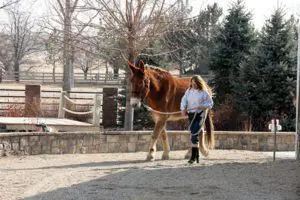Featured This Month

MULE CROSSING: Good Basic Training Includes Common Sense, Part 1
By Meredith Hodges Many times I have been asked, “Is training a mule any different than training horses?” The answer to this is “Yes.” Since a mule is half horse and half donkey, the trainer must learn to appeal to the donkey half of the mule as well as the horse half. Donkeys are very sensitive animals requiring infinite patience and understanding. They possess a natural willingness to please which is evident when their training is approached properly. When training is done incorrectly, they will exhibit resistant behaviors that include everything from standing stock still to running off. Both donkeys and mules must always be given clear verbal communication and body language so they can comprehend exactly what is being asked of them. When training your equine for saddle or driving, you will need to spend adequate time conditioning his muscles correctly. In order for things to happen as effortlessly as possible, the equine needs strength and coordination in good posture and a clear understanding of what is expected of him. This is why it is so important to spend months instead of merely weeks on leading training. Since an equine’s bones are only cartilage and not hardened until approximately ...
